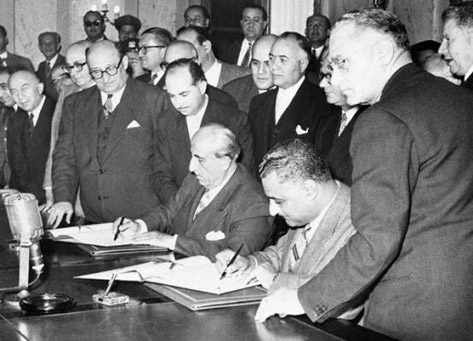Syria 1956-57

Syrian president Shukri Kuwatli (left) signs agreement forming the United Arab Republic with Egyptian president Abdel Nasser
None of the Syrian governments favored by the United States in the early 1950s was able to remain in power very long (see the earlier Syrian case on this website). This record of failure did not, however, deter U.S. officials from trying yet again to foment a right-wing coup, even though they feared that the army was falling under communist domination. The machinery began to get put in motion in early 1956 when the U.S. ambassador was contacted by rightist military officers. Dulles and Eisenhower, concerned that Syria was becoming increasingly pro-Soviet, opened discussions with the British on covert action not only there but throughout the Middle East . Operation Straggle, as the Syrian component was called, envisioned a military coup that would be triggered by various violent activities on the country's borders, duly fomented by the Turks, the British Secret Service, and the CIA. Key “conservative elements in Syria , dissatisfied with the present situation,” were to be provided with cash and, once more, promises of rapid U.S. recognition. However, the plot was uncovered shortly before it was scheduled to take place and the principal CIA officers had to flee the country. Even this did not discourage the U.S. , and the next year, Straggle was reborn as Operation Wappen, with CIA officers trying to organize right-wing officers in the army and a former coup plotter standing by in Beirut . Once again, the operation was blown. This time, the consequences were lasting: the Syrians not only expelled the CIA organizers but placed the U.S. embassy under constant surveillance and overhauled the army; soon after, each country's ambassador was told to leave. Thus, even before the Syrians merged (temporarily) their country with Egypt , the institutional bases of any future coup attempts had been destroyed. Eisenhower and, after him, other presidents were left only with the choice between invasion (which could have led to a Soviet attack on Turkey ) and routinely hostile activities. Remarkably, as late as 2008, these still seemed to be the only alternatives envisioned by U.S. policy makers. 1
1) Dulles to Moose, 21 September 1956, FRUS 1955-1957 , vol. 13: 593; Gorst and Lucas (1989); Little (1990; 2004: 670-7 [Syria], 678-83 [Egypt]); Hersh (2006b: 33).
